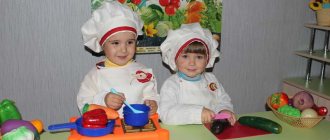Project “Proper nutrition is the key to health”
Authors:
Fedyunina Vera Vladimirovna, teacher
Ivanenko Elena Alekseevna, teacher
MA preschool educational institution Golyshmanovsky CRR-kindergarten No. 4 “Yolochka”
Project participants : pupils of the senior group “Solnyshko”, parents of pupils
Introduction
Rational nutrition is one of the environmental factors that determine the normal development of a child. It has a direct impact on the baby’s life activity, growth, and health.
Only proper, balanced nutrition that meets the physiological needs of a growing body increases resistance to various adverse effects. It is in preschool age that we must instill in children the concepts of “proper nutrition”, “healthy nutrition”, “healthy nutrition” in order to protect our children from frequently advertised chips, chocolates, hamburgers and soda.
Proper nutrition is the key to good health, performance, vigorous activity, excellent mood, the most important and indispensable condition for our health and longevity.
It ensures the normal physical development of the child, prevents the occurrence of such abnormalities as stunting, anemia, obesity, allergic manifestations, and digestive disorders.
Nutrition has a decisive influence on the development of the child’s central nervous system, his intellect, his state of performance, and contributes to the formation of an organism capable of overcoming the difficulties of life.
The problem is that children know little about the vitamins necessary for human health contained in vegetables and fruits, their beneficial properties, and do not eat enough natural vegetables and fruits, which they need to maintain and strengthen their health
Relevance: In childhood, the level of child health is largely determined by the quality of nutrition. A child's body differs from an adult in its rapid growth and intense metabolic processes. Eating wisely means not only ensuring that food contains proteins, fats, carbohydrates, vitamins, mineral salts and water in the required quantities, but also meeting the individual needs of children, taking into account the physiological characteristics and social conditions of life.
Project goal : developing healthy eating skills in preschool children.
Project objectives:
1. Formation of the basics of rational nutrition in preschoolers.
2. Introducing children to healthy products.
3. Formation of preschoolers’ ideas about the need to take care of their health.
4. Improving parents’ understanding of the importance and significance of proper nutrition for the child’s health and their own health.
5. Involving children and their parents in joint activities to study a healthy lifestyle, food hygiene, principles of food safety and quality.
6. Generalization and systematization of acquired knowledge about healthy eating.
Hypothesis: the implementation of the project will have a positive impact on the development of cognitive activity of children in our group, in terms of familiarizing them with the principles of healthy eating.
Project implementation stages
1. Preparatory
— selection of subject pictures and illustrations;
— selection of fiction (poems, stories, fairy tales, proverbs, sayings);
— work with methodological material, literature on this topic;
— notifying parents about an upcoming project;
— Questioning parents about proper nutrition.
2. Main
During the project implementation the following work was carried out:
Cognitive development
— Game situations: “Help put vegetables and fruits in different baskets”, “Guess what it is?”, “Salted or fresh?” (development of the sense of touch and taste buds);
— Conversations: “What vitamins are contained in vegetables and fruits”, “Healthy lifestyle”, “What can be prepared from vegetables and fruits”
— Conducting the “Guess the Taste” experiment;
— Didactic games: “Useful and harmful”, “The fourth odd one”, “Tops and roots”, “Which vegetable, guess?”.
Social and communicative development
— Didactic games: “Ascorbic acid and her friends” (introducing children to vitamins), “Find a home for vitamins” (distribute vitamins among vegetables and fruits),
“Riddles from the garden” (silhouette image of vegetables and fruits),
“Merry cooks” (cook borscht and compote),
“Wonderful bag” (guessing vegetables and fruits by touch,
“Recognize by taste”, “Recognize the dish”, puzzles “Vegetables and fruits”, “Match by color”, “Find a pair”
Speech development
— “What juice?”, “What jam?”, “What jam?” (Agreeing the endings of adjectives and nouns)
— “Call me affectionately” (use of diminutive suffixes)
“Our riddles” (composing descriptive riddles about vegetables and fruits)
— “One is many” (ending nouns)
— “Find by description” (development of coherent speech)
— “What grows where? (use of prepositions)
— Learning poems: Y. Tuvim “Vegetables”, learning proverbs, sayings, tongue twisters, counting rhymes, riddles
— Reading Literature: D. Rodari’s fairy tale “The Adventures of Chipolino”, Belarusian folk tale “Pykh”, S. Mikhalkov “Dispute of Vegetables”, “About the girl Yulia, who ate poorly”, V Suteev “Sack of Apples”, G. Sapgir “Riddles from the Garden” , S. Marshak “Signor Tomato”, V. Korkin “What grows in our garden?”, L. Zilberg "Useful product."
Artistic and aesthetic development
— Application “Preparations for the winter”
— Modeling “Vegetables in a plate”
— Plasticineography “Fruit Garden”
— Group work “Vitamins in vegetables and fruits”
— Coloring pages “Vegetables and fruits” - independent activity for children
Physical development
— Outdoor games: “Cucumber, cucumber”, “Gardener”, “Baba sowed peas”, “Tsar Peas”, “Vegetables and fruits”, “Tops and roots”, “Healthy - harmful” (similar to “Edible - not edible” ).
— Round dance games: “Zucchini”, “Harvest”, “Apple Tree”, “Let’s go through the raspberries to the garden”, “Hello, Autumn”.
— Finger gymnastics: “Orange”, “Vegetables”, “Cabbage”, “We are cooking, we are preparing compote”, “Our bed”, “We are standing in the garden”, “Apple”, “Lariska has two radishes”, “Fruits”, “The girl Arinochka has vegetables in her basket”, “Vegetable Garden”
3. Final
Final entertainment : theatrical performance of a musical fairy tale based on the cartoon “The Bremen Town Musicians”, “In a Certain State”.
Conclusion
So, the implementation of this project made it possible to expand and enrich children’s knowledge about proper nutrition and its benefits.
The children learned a lot about the vitamins contained in vegetables and fruits, gained practical skills in preparing some healthy dishes, and learned how to properly set the table;
They know how to distinguish between vegetables and fruits and choose the most useful ones. They know the importance of vitamins for the health of the body.
Joint project activities united educators, children and parents in common creative work and united the child-adult team.
As a result of working on the project, children became more interested in their health through healthy eating.
Our hypothesis was confirmed: the implementation of the project had a positive impact on the development of cognitive activity of the children in our group, in terms of familiarizing them with the principles of healthy eating.
List of used literature
1. Andreev Yu.A. New Three pillars of health - M.: Phoenix. 2014. - 350 p.
2. Gumenyuk E.I., Slisenko N.A. “Proper nutrition of preschool children.”-M, - 2011.
3. Konyaeva L. “Be healthy, baby” // Preschool education .- No. 11, 2004.
4. Makhoneva M. “Raising a healthy child” // Preschool education .-No. 6, 2002.
5. Soroka N.F. Nutrition and health. - Minsk, 2021. - 242 p.
6. Unzorg R. Encyclopedia of health. Healthy eating. - M.: "Christina and Co", 2012. - 234 p.
7. Internet resources.
“Certificate of publication in the media” Series A No. 0007681-0007682
We invite teachers of preschool education in the Tyumen region, Yamal-Nenets Autonomous Okrug and Khanty-Mansi Autonomous Okrug-Yugra to publish their teaching materials: - Pedagogical experience, original programs, teaching aids, presentations for classes, electronic games; — Personally developed notes and scenarios of educational activities, projects, master classes (including videos), forms of work with families and teachers.
Why is it profitable to publish with us?
1. “Kindergartens of the Tyumen Region” is an officially registered specialized media outlet at the federal level. 2. The activities of the editorial office are supported by the Department of Education and Science of the Tyumen Region 3. We issue a “Certificate of Publication” in the media. 4. The document has a unique number, is entered in the register, has the original seal of the editorial office of the online publication and signature. 5. “Certificate of publication” in the media is sent to the author in both paper and electronic versions.
Details >>>
Sample “Certificate of publication of author’s methodological material in the media.”pdf
Share
How to eat right
These tips are universal for both adults and children:
- Small meals 5-6 times a day, with breaks of no more than 4 hours. The last meal is 2 - 3 hours before bedtime.
- 3 main meals are recommended: breakfast, lunch and dinner - and 2 snacks. Breakfast should account for 15 - 25% of the caloric intake of the diet, lunch - 30 - 40%, dinner - 30%. Snacking can account for about 10% of your daily calories.
- Preference is given to natural products with high nutritional value and freshly prepared dishes.
- A varied, balanced diet.
- A menu that takes into account seasonality and area of residence.
- The ratio of proteins, fats and carbohydrates in the diet (for a healthy body) is 15:30:55. It is better to eat protein foods for breakfast and lunch, carbohydrates (mainly vegetables) in the evening.
- It is recommended not to overuse salt and sugar, foods with preservatives, dyes, flavor enhancers, fried and spicy foods - all of this may be present in the diet, but in limited quantities.
- The preferred methods of cooking are boiling, steaming, baking in the oven and grilling, frying without oil.
- The calorie content of the daily diet should be equal to or slightly less than the energy consumed during the day. The approximate daily calorie intake for a healthy person depends on age and gender: for a child from 1 to 2 years old - 1200 kcal, from 2 to 3 - 1400 kcal, up to 1800 - for a child 3 - 7 years old, 2300 - 2500 - for teenagers 11 – 14 years old, 2500 – 2900 – aged 14 to 18 years.
- It is important not to forget about maintaining water balance. Children from 1 to 3 years old are recommended to consume 1100-1200 ml of liquid per day, from 4 to 8 years old - 1600 ml, from 9 to 13 years old - 1900-2100 ml, and adolescents 14-18 years old - 2000-2500 ml. In this case, all liquid entering the body is taken into account: soup, tea, juices, etc.
How should parents behave in order to instill in their child the right eating habits, form and timely regulate eating behavior in general?
What influences food preferences
In addition to taste itself, the formation of a child’s food preferences is also influenced by:
- The smell of food;
- Its consistency;
- Compound;
- Appearance of dishes.
When introducing complementary foods when the baby begins to show interest in food, it is important not to make mistakes and take care of all the components of the product offered to the child:
- It should arouse interest with its design;
- Stimulate appetite by smell;
- The consistency and composition are appropriate for the baby’s age.
Agusha products meet all the requirements for baby food and not only help the baby develop correct eating behavior, but also attract him with interesting packaging.
It is worth noting that if a child categorically refuses food of a certain consistency (for example, with pieces), prefers food of the same color, or eats in unusual conditions (only in the dark or only on the floor), it is worth consulting with a specialist.
What to do if a child refuses certain foods? Naturally, he may not like foods or dishes that are still unknown and introduced into the baby’s diet for the first time. Is it too easy to accept your little gourmet's reluctance to accept this or that new dish? No, you need to patiently and repeatedly offer it to your child, sometimes masking it with your favorite dish. Patience and the parents’ own example, the family’s lifestyle as a whole can help overcome this problem.
It is possible and it is not possible
Sources of protein - the building material for a rapidly growing body - are meat, eggs, cottage cheese and fish
.
For feeding preschoolers, the best meats are considered to be lean veal, chicken, and turkey
.
The most preferable fish are cod, pike perch, pollock, hake, navaga and pink salmon
.
Delicacies, smoked meats, caviar and other “holiday” dishes are best served on holidays - they irritate the mucous membrane of the stomach and intestines, and are not of great value. Contrary to popular belief, fried foods can be given to young children, although it is better to give preference to boiled or stewed foods
. Cutlets and meatballs can be fried, but not too much - the fat in which they are fried can cause heartburn. It is much better to cook them steamed or in sauce.





